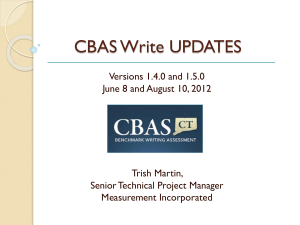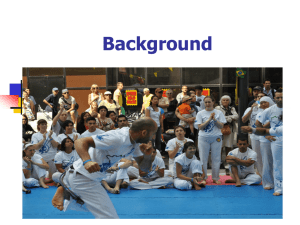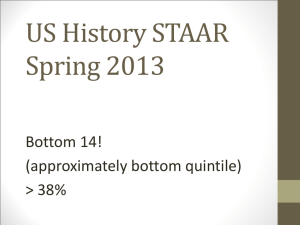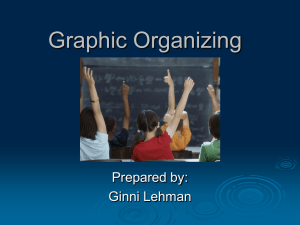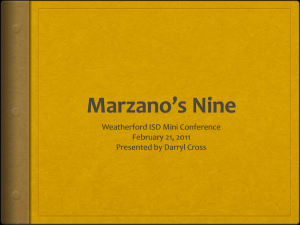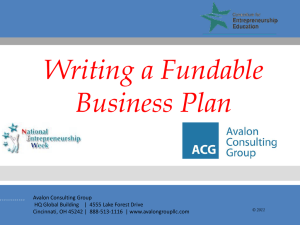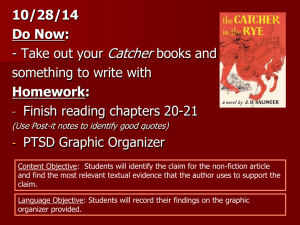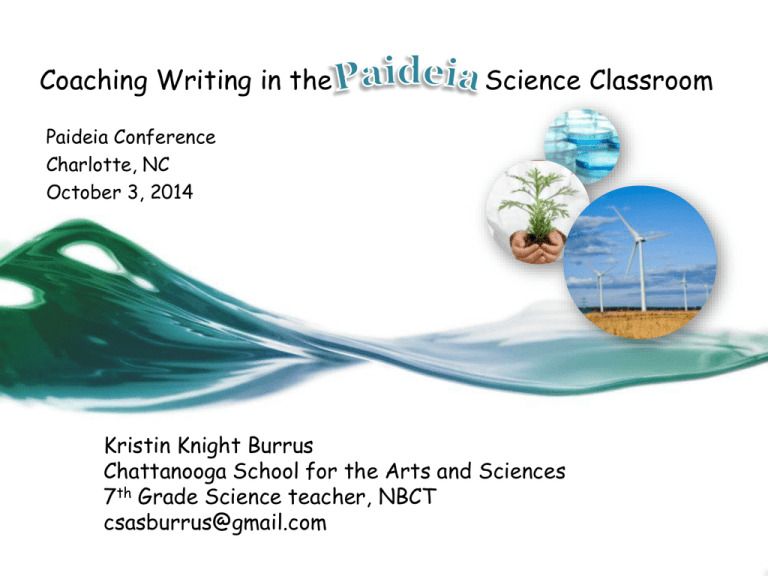
Coaching Writing in the
Science Classroom
Paideia Conference
Charlotte, NC
October 3, 2014
Kristin Knight Burrus
Chattanooga School for the Arts and Sciences
7th Grade Science teacher, NBCT
csasburrus@gmail.com
What kind of writing do you ask your students to do in science?
What helps them be successful?
Socrative Poll
Goals for today
• Scaffolding student
writing with graphic
organizers.
• Matching writing tasks
with texts.
– Informational
– Narrative
– Argumentative
• Creating prompts for
writing assignments.
• Assessment strategies
Pre-Seminar Writing
Graphic Organizers
•
Reading Symbols and Highlighting - Always give
students a reason for highlighting. (agree/disagree,
POV, claim/counterclaim, imagery, ideas, etc.)
•
•
•
•
•
•
Summarizing -MVP 5-3-1 / Bulls Eye
Visualizing & Connecting – Two Column Notes
FQR (Three columns – Facts – Questions – Response)
Anticipation Guides
Cause/Effect (fishbone)
Compare/Contrast (Venn)
Graphic Organizers to get students ready to read
science texts.
Reading Symbols
Say Something
P - Prediction
T-S – text to self connection
T-T – text to text connection
T-W – text to world connection
? – a question I have about the
text
QA – question answered
* - important detail
V – visual image here
I – inference
S – synthesizing/generalizing
statement or theme
Use these symbols when
highlighting text.
Teacher breaks a piece of
text into four sections.
At the end of each section,
the students complete one
of the following:
• Make a prediction.
• Ask a question.
• Make a comment.
• Make a connection.
This can be done with
partners and
shared/discussed with group.
Paideia Seminars – the fun part!
Planning Steps to Post-Seminar Writing
Common Core State Standards
Science and Technical Writing Standards
•
Argumentative
o
Write arguments focused on discipline-specific
content.
•
Informational/Expository
o
Write informative/explanatory texts, including
the narration of historical events, scientific
procedures/ experiments, or technical processes.
Argumentative Essay
Argumentation
Graphic
Organizers
Brainstorming for Arguments
Argument Organizers
Read, Write,
Think Essay Map
Informational / Expository Graphic Organizers
Innovation Seminar
Innovation Post-Seminar Writing Student Work
Small Group Planning
•
•
Read the text and plan (if available).
What kind of writing supports this text?
o
•
Narrative, Informational, or Argumentative
Create a prompt that fits the type of
writing you want students to do.
o
Use the “LDC Template Task Collection” to
create prompts.
•
What type of graphic organizers support
this prompt?
Break into 5 Groups:
1. Death of a Pine
2. Human Skeleton
3. Newton’s Laws of
Motion
4. Sex, Drugs,
Disasters, and the
Extinction of the
Dinosaurs
5. The Wonderful
Mistake
Share Group Ideas
Prompts for Science
Texts
HS Biology:
“Trash” Seminar
After observing maps,
pictures and objects from
the TN River , write a
report that examines the
cause(s) of pollution and its
effect on riparian
ecosystems. Support your
discussion with evidence
from the seminar and
additional classroom
resources.
Prompts for Science
Texts
Middle / High School
Science:
“Experiments and
Observations on Air” by
Joseph Priestley
After reading and discussing
“Experiments and
Observations on Air,” write an
entry in Priestley's Journal as
if he is in 2014 that describes
the relationship between
photosynthesis and cellular
respiration. Support your
discussion with at least two
quotes from the text.
Prompts for Science
Texts
Middle / High School:
Bicycle Seminar
After observing the bicycle and
reading the text, Pedaling
Through the Parts, write an
Edmodo blog for our science
class, in which you compare the
systems of the bicycle with
analogous systems of the body
in both form and function.
Include three systems of the
body and support your ideas
with evidence from the text and
your science book.
(We really will post these for your
science class to see!)
Assessing Writing
Writing checklist - argumentative essay
Criteria
Category
Claim or Thesis
A:
Exemplary
5
B:
Solid
4.5
C:
Competent
4
D / F:
Insufficient
≤ 3.5
Claim is clearly worded and well defined.
Acknowledge and distinguish the claim from alternate or opposing claims
Argument Support
and Evidence
Content
Support claim(s) with logical reasoning and relevant, accurate data and evidence that demonstrate
an understanding of the topic or text, using at least three credible sources. Use quotes from the text
as evidence.
Sentences and paragraphs contain original and interesting ideas with appropriate support
Works are cited correctly.
Organization
The introduction, body, and conclusion are organized and presented in such a clear and creative
way that the reader moves easily through the text.
Provide a concluding statement or section that follows from and supports the argument presented.
Mechanics and
Conventions
Very few errors exist in spelling, punctuation, capitalization, and usage.
Word Choice and
Sentence Fluency
Use words, phrases, and clauses to create cohesion and clarify the relationships among claims,
counterclaims, reasons, and evidence.
Voice and
Presentation
Establish and maintain a formal style/voice
Easy to read handwriting OR Double spaced typing with well-defined margins.
Use 12 pt. Times New Roman font and double space.
Total Score
A = 20
B = 18
C = 16
D = 14
F ≤ 13
On-line, Interactive, Argumentative Essay Rubric
Rcampus.com
General Writing Rubric
Post Content
40 % Writings, artwork, and presentations
Mechanics and
Conventions
3 pts
Ideas
3 pts
Excellent
Post-Writing
assignment is
complete and
effectively
demonstrates the
student’s growth
and thorough
understanding of
language
conventions and
mechanics
Good
Post-Writing
assignment is
complete and
effectively
demonstrates a
proficient level of
understanding of
language
conventions and
mechanics
Excellent
Good
Post-Writing
assignment is
complete and
effectively
demonstrates the
student’s growth
and thorough
understanding of
the big ideas—
making
connections to the
seminar and reallife applications.
Student followed
guidelines for
post.
Post-Writing
assignment is
complete and
effectively
demonstrates a
proficient level of
understanding of
the big ideas—
making
connections to the
seminar. Student
followed
guidelines for
post.
Developing
Post-Writing
assignment is
complete and
demonstrates an
average level of
understanding of
language
conventions and
mechanics
Developing
Post-Writing
assignment is
complete and
demonstrates an
average level of
understanding of
the big ideas.
Student did not
follow all
guidelines for
writing post.
Needs
Improvement
Poor
missing
Post-Writing
assignment is
incomplete
Needs
Improvement
Poor
missing
Post-Writing
assignment is
incomplete
Sources
"English Language Arts Standards » Writing.” Science and Technical
Subjects. Common Core State Standards Initiative, 2014. Web.
27 Sept. 2014. <http://www.corestandards.org>.
"Project Write MSU." Graphic Organizers. Wikispaces, 15 June 2009.
Web. 28 Sept. 2014.
<https://projectwritemsu.wikispaces.com/file/detail/graphic+
organizers.pdf>.
"Essay Map." Essay Map. ReadWriteThink.org, 2014. Web. 28 Sept.
2014.
Appendix C: LDC Template Task Collection. Paideia Course Manual.
National Paideia Center, 2013. 91-95. Print.

